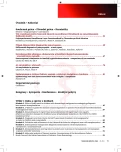Polycaprolactone Nanofibrous Layer Functionalized by Thrombocyte Rich Solution
Authors:
J. Horáková 1; R. Procházková 2; V. Jenčová 1; P. Mikeš 1; M. Cudlínová 1
Authors‘ workplace:
Katedra netkaných textilií a nanovlákenných materiálů, Technická univerzita v Liberci, Liberec
1; Transfuzní oddělení, Krajská nemocnice Liberec a. s., Liberec
2
Published in:
Transfuze Hematol. dnes,20, 2014, No. 3, p. 53-58.
Category:
Comprehensive Reports, Original Papers, Case Reports
Overview
Platelets hold a significant promise for the field of regenerative medicine and tissue engineering given their large content of growth factors. Released growth factors promote cell differentiation, proliferation, transcription of specific proteins, chemotaxis and other processes involved in tissue regeneration. Platelets in the form of platelet rich plasma are commonly used in vitro to stimulate cell proliferation of different types of tissue cultures. In the tissue engineering approach, cells are grown on nanofibrous scaffolds in order to create a system suitable for subsequent implantation into the human body. Nanofibrous scaffolds can be prepared from biodegradable and biocompatible polymers using electrospinning. A thrombocyte rich solution was used for modification of nanofibrous electrospun scaffolds made from the biodegradable polymer polycaprolactone, which is widely used in tissue engineering applications. The resulting scaffolds were modified in two ways: a) bathing in thrombocyte rich solution and b) spraying of thrombocyte rich solution in between forming nanofibers during the electrospinning process. Nanofibrous scaffolds were tested in vitro using mouse 3T3 fibroblasts and human dermal fibroblasts. Incorporation of thrombocytes into the nanofibrous layers increased proliferation of both cell types. The use of the spraying technique promotes cell ingrowth into 3D structures.
Key words:
platelets, electrospinning, scaffold, nanofibers, polycaprolactone
Sources
1. Langer R, Vacanti JP. Tissue engineering. Science 1993; 260 : 920-926.
2. Dahlin RL, Kasper FK, Mikos AG. Polymeric Nanofibers in tissue engineering. Tissue Engineering: Part B 2011; 17 : 349-364.
3. Beachley V, Wen X. Polymer nanofibrous structures: Fabrication, biofunctionalization, and cell interactions. Progress in Polymer Science 2010; 35 : 868-892.
4. Jirsak O, Sanetrnik F, Lukas D, Kotek V, Martinova L, Chaloupek J. A method of nanofibres production from a polymer solution using electrostatic spinning and a device for carrying out the method, US Patent, WO2005024101.
5. Frei R, Biosca FE, Handl M, Trc T. Funkce růstových faktorů v lidském organismu a jejich využití v medicíně, zejména v ortopedii a traumatologii. Acta chirurgiae orthopaedicae et traumatologeae čechosl.: Klinika dětské a dospělé ortopedie a traumatologie 2. LF UK a FN Motol 2008; 75 : 247-252.
6. Jakubova R, Mickova A, Bugzo M, et al. Immobilization of thrombocytes on PCL nanofibres enhances chondrocyte proliferation in vitro. Cell Proliferation 2011; 44 : 183-191.
7. Slapnička J. Vliv aktivované a neaktivované plazmy bohaté na trombocyty (PRP) na proliferaci lidských osteoblastů a fibroblastů in vitro. Praha 2009. Doktorandská disertační práce. Masarykova univerzita. Lékařská fakulta.
8. Nam J, Huang Y, Agarwal S, Lannutti J. Improved cellular infiltration in electrospun fiber via engineering porosity, Tissue Engineering 2007; 13 : 2249-57.
Labels
Haematology Internal medicine Clinical oncologyArticle was published in
Transfusion and Haematology Today

2014 Issue 3
Most read in this issue
- Differential diagnosis of pancytopenia – a case report
- AL amyloidosis in pictures
- Epidemiology and risk factors associated with Hodgkin´s lymphoma
- Polycaprolactone Nanofibrous Layer Functionalized by Thrombocyte Rich Solution
